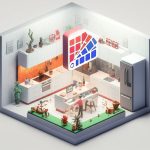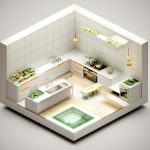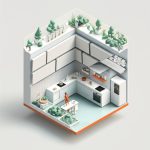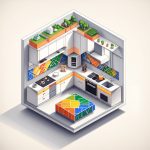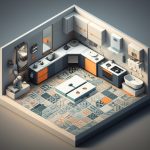Dreaming of a kitchen with the warmth and character of natural wood, but cringing at the custom cabinet price tags? Natural wood RTA cabinets (ready-to-assemble) offer a compelling alternative, letting you achieve that desired aesthetic without breaking the bank. The key is navigating the options smartly, focusing on quality materials and construction.
At a glance:
- Learn how to identify high-quality natural wood RTA cabinets that will stand the test of time.
- Understand the pros and cons of different wood types (hardwood, plywood, HDF, MDF) in RTA construction.
- Discover smart buying strategies to maximize your budget without compromising on style or durability.
- Get practical tips for assembly, installation, and long-term care of your natural wood RTA cabinets.
Why Choose Natural Wood RTA Cabinets?
The kitchen remains the heart of the home, and increasingly, homeowners are seeking a luxury look without the luxury price. RTA cabinets offer a sweet spot, blending customization, durability, and affordability. Natural wood finishes, in particular, are experiencing a resurgence as homeowners move away from sterile, all-white kitchens towards warmer, more textured spaces.
Natural wood RTA cabinets offer plenty of upsides:
- Aesthetic Appeal: The unique grain patterns and warm tones of natural wood bring character and sophistication to any kitchen.
- Cost Savings: RTA cabinets eliminate pre-assembly labor costs, resulting in significant savings compared to custom cabinetry.
- Customization: RTA cabinets come in a wide range of styles, finishes, and sizes, allowing you to create a kitchen that perfectly suits your needs and taste. The formula to color match any trims you wish to add is also provided.
- Durability (When Chosen Wisely): With proper selection of materials and construction, natural wood RTA cabinets can rival the longevity of custom options.
Decoding the Materials: What Makes a Quality Natural Wood RTA Cabinet?
Not all natural wood RTA cabinets are created equal. The materials used play a crucial role in determining their durability, stability, and overall value. Let’s break down the key components:
- Hardwood: Often used for face frames and doors, hardwood brings strength and beauty. Think birch, maple, or oak. It provides a solid framework and a visually appealing surface. Solid wood face frames and doors, as seen in Mahogany Glazed finish cabinets, offer a warm, cinnamon coloring that brings warmth to the kitchen. Important note: Hardwood is a natural material and adjusts to the environment. Expect some expansion and contraction with humidity and temperature changes; extreme conditions can cause warping or cracking.
- Plywood: The workhorse of cabinet boxes. Plywood is a laminated wood product that is exceptionally strong and resistant to warping. It provides a stable base for countertops and withstands the daily wear and tear of kitchen use. Look for cabinets with ½ inch or ¾ inch plywood construction for optimal durability. Cabinets like Florence Grey Shaker feature a framed cabinet box made of ½ inch plywood.
- HDF (High-Density Fiberboard): An engineered wood product that excels in cabinet doors. HDF resists humidity and temperature changes better than solid wood, minimizing the risk of warping or cracking. It provides a smooth, consistent surface for painting or applying finishes. As seen in Navy Blue Shaker cabinets, doors are often wood frames with HDF doors.
- MDF (Medium-Density Fiberboard): Similar to HDF, but less dense and therefore more flexible and affordable. MDF is suitable for painted cabinet doors, but it is less resistant to moisture than HDF.
Material Selection Cheat Sheet:
| Material | Strengths | Considerations | Ideal Use |
| :——– | :———————————————– | :——————————————————– | :———————————————— |
| Hardwood | Strength, beauty, classic look | Susceptible to humidity/temperature changes, costlier | Face frames, doors |
| Plywood | Strength, stability, moisture resistance | Can be more expensive than particleboard | Cabinet boxes, shelves |
| HDF | Humidity resistance, smooth surface, paintable | Less strong than hardwood or plywood | Cabinet doors (especially painted finishes) |
| MDF | Affordable, smooth surface, paintable | Less durable and moisture-resistant than HDF or plywood | Cabinet doors (lower-cost options), some panels |
Example: The Elegant White Shaker cabinets feature a cabinet box made of plywood and the door is high-grade MDF with a hardwood face frame. Drawer boxes are natural maple. This combination offers durability, stability, and a classic aesthetic.
Consider these options based on possible surrounding context: * Shop RTA Kitchen Cabinets * Find Quality RTA Cabinets Here * Best RTA Cabinet Buying Guide * Explore RTA Kitchen Cabinets * Smart RTA Cabinet Choices
Key Construction Features to Look For
Beyond the materials, pay close attention to the construction details. These features significantly impact the cabinet’s structural integrity and longevity:
- Dovetail Joints: A hallmark of quality drawer construction. Dovetail joints interlock tightly, creating a strong and durable bond that resists pulling apart.
- Soft-Close Hinges and Glides: These prevent slamming and extend the life of your cabinets. Soft-close mechanisms are now standard on many high-quality RTA options. Mahogany Glazed cabinets feature full extension soft-close glides on drawers and concealed soft-close hinges on doors.
- Full Overlay Doors: These doors cover nearly the entire cabinet face, creating a seamless, modern look. Minimal gaps between doors provide a cleaner aesthetic.
- Plywood Shelves: Opt for plywood shelves (at least ¾ inch thick) for maximum weight capacity and resistance to sagging.
- Solid Wood Drawer Boxes: Choose solid wood drawer boxes over particleboard or MDF for enhanced durability. The Florence Grey Shaker features a ⅝ inch solid wood drawer box with dovetail joints.
Smart Buying Strategies: Getting the Most for Your Money
- Research Reputable RTA Cabinet Stores: Look for retailers with clear listings of materials, transparent shipping and return policies, and responsive customer support. At RTAHQ, every collection is carefully vetted for quality, aesthetics, and value.
- Read Reviews Carefully: Pay attention to customer feedback regarding assembly ease, product quality, and customer service.
- Request Samples: Before committing to a large order, request samples of the cabinet doors and finishes to ensure they meet your expectations.
- Take Advantage of Design Assistance: Many RTA cabinet stores offer design services to help you plan your kitchen layout and choose the right cabinets.
- Consider Assembly Services: If you’re not comfortable assembling the cabinets yourself, inquire about professional assembly services. BILT app 3D interactive assembly instructions are often available.
- Don’t Be Afraid to Mix and Match: Combine different cabinet styles and finishes to create a unique and personalized kitchen design.
- Invest in Quality Hardware: Upgrading the knobs and pulls can significantly enhance the overall look and feel of your natural wood RTA cabinets.
Assembly and Installation Tips for Success
- Inventory All Parts: Before you begin assembly, carefully inventory all the parts to ensure that nothing is missing.
- Read the Instructions Thoroughly: Take the time to read the assembly instructions carefully before you start putting things together.
- Use the Right Tools: Make sure you have the necessary tools for assembly, including a screwdriver, drill, level, and measuring tape.
- Work in a Clear, Well-Lit Space: Assembly is easier and safer in a clean, well-lit workspace.
- Don’t Over-Tighten Screws: Overtightening screws can damage the cabinet components.
- Take Your Time: Rushing through the assembly process can lead to errors and frustration.
- Consult a Professional: If you’re unsure about any aspect of the assembly or installation process, consult a qualified professional.
Maintaining the Beauty of Your Natural Wood RTA Cabinets
- Clean Regularly: Wipe down your cabinets regularly with a damp cloth to remove dust and grime.
- Use Gentle Cleaners: Avoid harsh chemicals or abrasive cleaners, which can damage the finish.
- Protect from Moisture: Wipe up spills immediately to prevent water damage.
- Control Humidity: Maintain a consistent humidity level in your kitchen to prevent warping or cracking.
- Consider Protective Coatings: Apply a protective coating to the cabinets to prevent stains and scratches.
Quick Answers: Common Questions About Natural Wood RTA Cabinets
Q: Are RTA cabinets really as durable as custom cabinets?
A: High-quality RTA cabinets, made with durable materials like plywood and hardwood, can absolutely rival the longevity of custom cabinets, especially if you choose smart construction (dovetail joints, soft-close hardware). The materials used for RTA cabinets is strategically chosen to create a durable, quality cabinet that will last, even under the toughest conditions.
Q: Will natural wood RTA cabinets warp or crack?
A: Solid wood components can be susceptible to warping or cracking in extreme humidity or temperature fluctuations. However, cabinets with HDF doors and plywood boxes are less likely to be affected.
Q: Are natural wood RTA cabinets difficult to assemble?
A: Assembly difficulty varies depending on the cabinet design and your experience level. Many RTA cabinets come with clear instructions and may even offer 3D interactive assembly guides.
Q: How much do natural wood RTA cabinets cost?
A: The cost varies depending on the materials, style, and size of the cabinets. However, RTA cabinets are generally significantly less expensive than custom options.
Actionable Close: Your Next Steps Towards a Beautiful, Budget-Friendly Kitchen
Ready to transform your kitchen with natural wood RTA cabinets? Here’s a quick start guide:
- Define Your Style: Determine the overall aesthetic you want to achieve (e.g., rustic, modern, traditional).
- Set a Budget: Establish a realistic budget for your cabinet project.
- Research RTA Cabinet Stores: Identify reputable retailers with a wide selection of natural wood options.
- Order Samples: Request samples of your favorite cabinet styles and finishes.
- Plan Your Layout: Use online kitchen design tools or consult with a professional designer to create a functional and stylish layout.
- Place Your Order: Carefully review your order before submitting it to ensure accuracy.
- Prepare for Assembly: Gather the necessary tools and clear a workspace for assembly.
By following these steps, you can confidently embark on your natural wood RTA cabinet journey and create a kitchen you’ll love for years to come, all while staying within your budget.
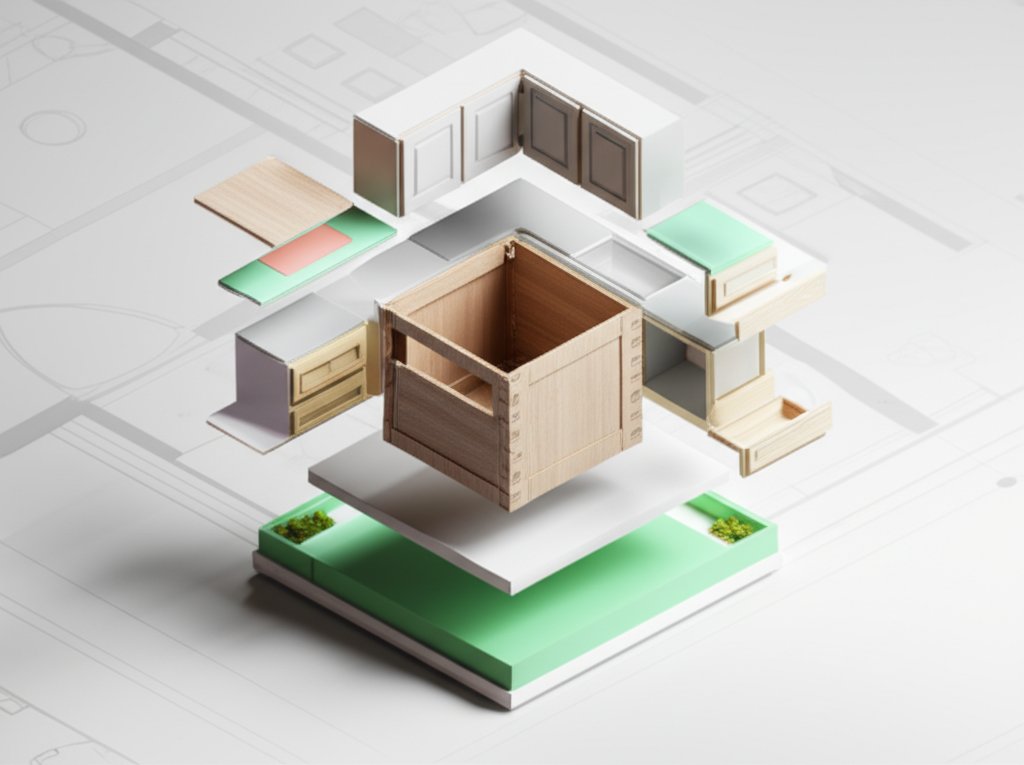
- Backsplash Colors for White Cabinets: Find Your Perfect Match - November 19, 2025
- Backsplash Ideas for White Cabinets: Find Your Perfect Style - November 18, 2025
- White Tile Backsplash Kitchen: A Classic and Clean Design - November 17, 2025

